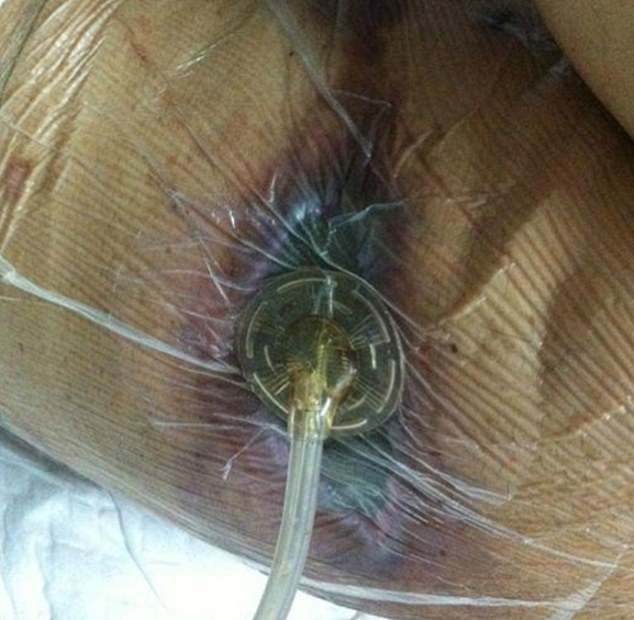Man, 55, develops rare flesh-eating disease after contracting common childhood virus




A middle-aged man was diagnosed with the virus that causes chickenpox and shingles, and developed a rare and potentially life-threatening infection that affected the flesh on his chest.
The 55-year-old man, who was being treated for shingles, went to the hospital with severe chest swelling and a large open wound leaking a foul-smelling fluid. Doctors discovered it was a rare complication of the herpes zoster virus, also known as shingles.
The flesh-eating infection, medically known as necrotizing fasciitis, is usually caused by bacterial infections.
Although rare, it can develop after infection with the virus that causes chickenpox and shingles. The severe rash gives way to open sores that welcome invading bacteria, which break down skin tissue.

Doctors used a vacuum-like device to drain the abscess after doctors removed layers of dead tissue
The patient was being treated by doctors in Najran, Saudi Arabia, for shingles, a painful rash that mainly affects older people who had chickenpox as children.
Even after a person recovers from chickenpox, the herpes zoster virus remains dormant in the person’s body. It can reactivate in old age, causing shingles.
The patient also had diabetes, which can weaken the immune system and affect its ability to control the virus.
About one million Americans are diagnosed with shingles each year.
Shingles can be prevented with a vaccine that protects nearly 100 percent of people from infection. About 30 percent of seniors eligible for the vaccine have received it.
The man developed the typical painful shingles rash on his chest and upper abdomen.
The rash was treated with a cream and an antiviral drug commonly used to treat herpes viruses.
About a week after starting the antiviral medication, he developed pain and swelling in his chest near the rash that did not respond to topical treatment. The pain persisted and he developed a high fever.
When he arrived at the emergency room, doctors reported that the swelling on the left side of his chest was “massive,” with pus discharge and “a foul odor, accompanied by throbbing pain and fever.”
The ulcer on his chest was slightly larger than a standard size piece of printer paper.
Doctors gave him intravenous antibiotics and performed emergency surgery to drain the fluid and remove layers of dead tissue. During the surgery, doctors discovered severe skin damage that had penetrated deeper into the man’s muscles.
Cultures of the man’s wound fluid revealed that the strains were Staphylococcus aureus and Clostridium perfringens. These strains are resistant to certain antibiotics and therefore difficult to treat effectively.


A 55-year-old man presented to the hospital with a serious case of a bacterial flesh-eating infection that had caused a huge ulcer on his torso
For five days in the hospital, doctors cleaned and treated the wound. Then a plastic surgeon closed the chest wound, using a vacuum for six days to let it heal, and then stitched it up.
The patient was discharged in good condition after 16 days in the hospital, with the infection completely gone. His ordeal was described in detail in the American Journal of Case Reports.
The shingles virus causes severe itching in a specific area, usually on one side of the body. This itching progresses to a painful rash and fluid-filled blisters that burst and become ulcers.
The open wounds are an ideal gateway for bacteria that cause secondary infections.
Treat a case of flesh-eating bacteria promptly with antibiotics and removal of layers of dead tissue.
Necrotizing fasciitis can spread rapidly and destroy more and more tissue the longer it is left untreated. The CDC estimates that there are between 700 and 1,200 cases of necrotizing fasciitis in the U.S. each year.
To fight infection, the immune system sends immune cells to fight the infection. But this response can lead to widespread inflammation throughout the body, potentially reducing oxygen flow to vital organs.
Surgery to remove the dead tissue is crucial. Researchers find that almost 100 percent of patients die without this surgery.




